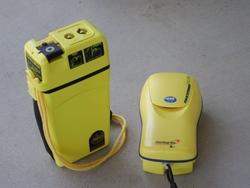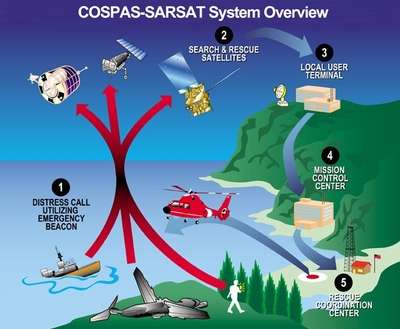New Era of Safety and Security Has Arrived
July 1 dawned on a new era in safety and security in the U.S.,
and it has nothing to do with Homeland Security or our good friends
at the TSA. Personal Locator Beacons are finally legal here,
providing pilots, and everyone else, a pocket-sized personal
distress-signaling device that uses the latest 406 MHz alerting
technology to ensure a rapid rescue from whatever life- or
limb-threatening mess you've gotten yourself into.

Personal Locator Beacons (PLBs) are compact and affordable
versions of the expensive 406 MHz ELTs that few of us can afford to
install in our aircraft. Even the FAA has jumped on the PLB band
wagon: in the July/August 2003 issue of FAA Aviation News, the FAA
concluded, "if you have no plans to install a 406 MHz ELT unless
the FAA mandates you install one, a 406 MHz PLB might provide you
the life saving edge you need."
What's better about 406MHz, vs good old 121.5?
That 'lifesaving edge' comes from the advantages 406 MHz offers
over the old-fashioned 121.5 MHz technology that the ELTs we have
been required to install are based upon. There are manifold
improvements in alert notification and location accuracy due
primarily to two factors inherent in every 406 MHz beacon,
regardless of what additional capabilities they include.
These newest locators are not going to generate false alarms
when they're dropped, either; they are manually-triggered only.
Doug Ritter, the clever, though bearded, fellow who runs Equipped
to Survive, told us, "The downside is they won't go off as a result
of a crash and someone has to survive and remain conscious. Of
course, as you know, often the ELT either doesn't go off or the
signal is not transmitted because the antenna is broken off or the
fuselage blocks it. The up side is that there are no false alerts
as a result of hard landings."
Stronger signal; fewer false alerts; better I.D.
The typical 121.5 MHz beacon puts out only 100 milliwatts; the
406 MHz signal is a full 5 watts, a 5000% increase in power. The
signal is also digitally-encoded with a unique identification
number so that authorities will know who is in distress. (A free
registration provides authorities contact phone numbers with which
to mitigate false alerts, thereby saving limited resources for the
real thing, and in many instances allows for the nearly immediate
launch of search and rescue operations.) The better than 99% false
alert rate for 121.5 MHz beacons is one reason that satellite
alerting from them is being phased out worldwide.
More-available, more accurate: smaller, quicker searches.

PLBs use the same COSPAS-SARSAT satellite alerting system as do
existing ELTs, but add another layer of capability. The 121.5 MHz
alerts are processed only by low earth-orbiting satellites, while
406 MHz alerts are also picked up by geostationary satellites that
cover the earth from 70 degrees North to 70 degrees South
latitudes. While the average time to notification for a 121.5 MHz
alert is six hours (and is often far longer), the PLB alert is
processed in a matter of minutes. This time saved can mean the
difference between life and death in a survival situation.
Because of the powerful signal, location accuracy is improved from
an average of a 13 NM radius (which requires covering 531 square
nautical miles of potential search area), to only 2 NM, giving a
search area of just 12.6 square nautical miles. A GPS-equipped PLB
provides even greater accuracy, within 280 feet, virtually pinpoint
accuracy. The advantages are obvious.
What if I like 121.5?
All PLBs also include a low-powered (25 milliwatt) 121.5 MHz
homing signal to allow search and rescue forces to use their
existing Direction Finding gear to home in on your final location.
A Morse code P in the "whoop, whoop" 121.5 MHz aural signal
differentiates a PLB from the ELT transmission we are used to
hearing.

This is proven technology. Thousands have been rescued in the
maritime environment where 406 MHz beacons have been widely
available and required on many boats for years. A PLB test program
conducted in Alaska since 1994 has about 400 persons saved to its
credit with only 378 PLBs registered (many are rentals or loaners
that have been used by multiple persons and groups). In 2002 there
were 27 people rescued in Alaska from PLB alerts. Worldwide, where
PLBs have been available for years, numerous rescues have resulted
from PLB use. PLBs work; they save lives.
$?
How much will this pocket full of protection cost you? Prices
start at under $600 for a basic 406 MHz PLB that weighs in at about
a pound. A few more bucks will get you the added accuracy of GPS
capability and/or small and lighter. (Compare that to the $1700
plus cost of installation that a 406 MHz ELT will set you
back.)
If you're a rental pilot, by carrying a 406 MHz
PLB you're covered no matter what plane you rent. The PLB is also
not limited to use in your aircraft -- you can take along this
technological security blanket anywhere that you or your loved ones
might be susceptible to being presented with a survival situation,
be it hiking, boating, what have you. [You are unlikely to need to
cut off your arm to survive if you've got a PLB with you --
ed.]
The best place to learn more about PLBs is on our favorite
aviation survival guru Doug Ritter's Equipped To Survive
site. Besides articles on PLBs with lots more details on how they
work and why they are the greatest thing since GPS, he has also
assembled "The Ultimate Personal Locator Beacon FAQ" that has well
over a hundred answers to the most common questions you might have
on the subject (and many you didn't even know you should ask).
 Classic Aero-TV: The Switchblade Flying Car FLIES!
Classic Aero-TV: The Switchblade Flying Car FLIES! ANN FAQ: Q&A 101
ANN FAQ: Q&A 101 ANN's Daily Aero-Term (04.12.24): Discrete Code
ANN's Daily Aero-Term (04.12.24): Discrete Code ANN's Daily Aero-Term (04.13.24): Beyond Visual Line Of Sight (BVLOS)
ANN's Daily Aero-Term (04.13.24): Beyond Visual Line Of Sight (BVLOS) ANN's Daily Aero-Linx (04.13.24)
ANN's Daily Aero-Linx (04.13.24)





